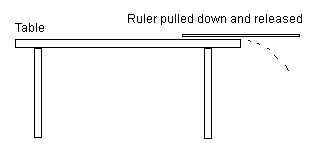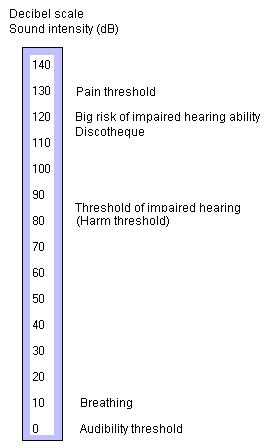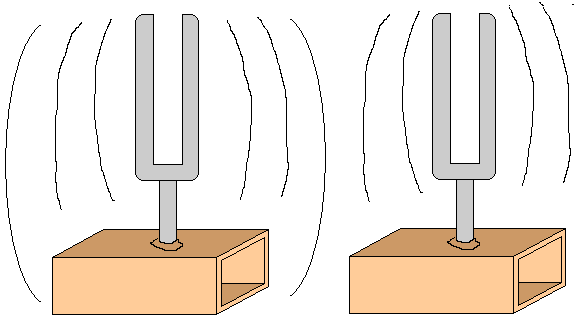1. Examples of sound sources
2. Frequency and pitch
3. Decibel scale (audibility threshold, pain threshold, and
harm threshold)
4. Sound generation and its transfer through the air - use
the particle approach
5. The speed of sound
6. Noise, echo and resonance
7. Human audibility frequency range
8. Ultrasound and infrasound
Examples of sound sources
* A guitar
vibrating
* A saxophone vibrating
* Loudspeaker vibrating because of feeding oscillating electric
currents
* Vocal cords vibrating e.g. a cat meowing
Frequency and pitch
If an object oscillates, the surrounding air will also
oscillate. For example, if you hold a ruler firmly against a
table while half the ruler is outside the table edge, and
the overhanging ruler part is bent down and released, a
sound is heard.

Figure 1: Pull down the ruler and then release it. The ruler
oscillates up
and down and a specific tone sounds. Estimate the frequency?
If two metal objects are banged against one another, they
also begin vibrating. This is felt if holding the metal
objects. It can feel uncomfortable holding the metal objects
that one may want to drop them. The metal objects set the
surrounding air into vibration. The oscillating air reaches
our ears and we hear a tone. The reason we can hear the
sound is to be found inside our ears. Inside each ear there
is an eardrum. The eardrum is a small diaphragm oscillating
in pace with the sound condensations and dilutions. Nerve
impulses are sent to the hearing center in the brain.
If we instead let the ruler in the previous example extent
further from the table and struck, a slightly deeper tone is
heard. A deeper tone occurs when the ruler oscillates fewer
times per second. The ears are thus hit by fewer cycles per
second. We say the tone is lower, or we have a low tone. If
instead, only a small part of the ruler extends from the
table edge and struck, a higher tone is heard. This tone
oscillates more times per second. This makes the eardrums
oscillating more cycles per second.
Hz (Hertz) is the unit of sound. It means number of cycles
per second.
*
More cycles per second results in a higher tone (higher
frequency (Hz))
*
Fewer cycles per second results in a lower tone (lower
frequency (Hz))
When talking about high or low tones the term pitch is also
used, i.e. high-pitched and low-pitched tones.
Decibel scale (audibility threshold, pain threshold, and
harm threshold)

Figure 2: Decibel scale
The decibel scale is a way to measure of the intensity
(power) of a sound. The more intense a sound, the more ache
in the ears. In everyday life we say that we increase the
volume e.g. of a stereo equipment.
The decibel scale is structured so that 20 dB is experienced
twice as loud as 10 dB. 40 dB is experienced 4 times more
than 20 dB.
Sound generation and its transfer through the
air - use the
particle approach

Figure 3: Sound waves consist of condensations and
dilutions. The curved lines above are
condensations and the spaces in between are dilutions. The
air particles are crowded and alternately diluted.
The condensations and dilutions in air travel with a speed
of 340 m/s.

Figure 4: In the wave-formation above each condensation is
showed as a wave-crest and each dilution as a wave trough.
This wave-formation is called a sine curve. The amplitude
decides the intensity (power) of the sound. High amplitude
means that the sound is intense. The number of wave-crests
per second (cycles per second) decides whether the tone is
high (many cycles per second) or low (few cycles per
second).
The speed of sound
The speed of sound in air is 340 m/s. Mainly, the denser a
substance is, the faster the sound can travel through it.
The sound speed in water is 1500 m/s and in steel 5100 m/s.
Noise, echo and
resonance
Noise:
As seen above on the sounding speaker there is equal
distances between the sound waves. So we have a uniform
tone. With noise, the lengths between the sound waves are
not the same. The sound varies in an irregular manner.
Furthermore, the amplitude varies in an irregular way. If
experiencing the sound as unpleasant, it is called noise.
Echo:
If shouting close to a rock wall, it seems the rock wall
shouts back. This phenomenon is called echo. Echo means that
the sound waves bounce towards and off the rock wall and
further back to the person shouting.
Resonance:
If a tuning fork is struck it produces a uniform tone. When
this frequency is transferred onto another object, it too
begins oscillating at the same rate. The object resonates
(is in resonance with) with the tuning fork.

Figure 5: The tuning fork to the left is struck. Its sound
waves make the other identical tuning fork to oscillate with
the same frequency.
Try striking a tuning fork inserted in an acoustic chamber
while having an identical tuning fork with an acoustic
chamber close. Close with your hand the oscillations in the
first tuning fork and see what happens with the second
tuning fork. The second tuning fork still sounds. This
phenomenon is called resonance.
Human audibility frequency range
Humans can hear frequencies between 20 and 20.000 Hz. One
Hertz (1 Hz) is one cycle per second. 20 Hz means 20 cycles
per second.
Ultrasound and infrasound
All sounds below 20 Hz are called infrasound. These sounds
cannot be heard. Research has shown that some infrasound can
make us feel bad, sick or tired.
Ultrasounds have frequencies above 20.000 Hz. These sounds
as well we cannot hear. Ultrasound is used at fetal
diagnostics. The ultrasound device is hold against the
mother’s stomach. The sound waves bounce back from various
fetal tissues inside the womb. The device does this
continuously and we can see the baby moving on a TV screen.
Bats also send out ultrasounds. The ultrasounds bounce off
objects located by the bat. Some of these objects are
possible preys. The echo comes back to the bat. Also dogs
can hear ultrasounds. Dog Whistles emit ultrasound. When
blowing into dog whistles we humans hear nothing at all.
However, for the dog, it sounds a lot.
Copywrite NGU, Northern Pontifical Academy 2025 (A.I.C.)